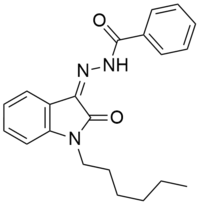
Photo from wikipedia
Background/Aims: Hydrazone and acylhydrazone derivatives, which are produced from aldehyde reacting with hydrazine or acylhydrazine, have been reported to exhibit antitumor activities. However, the angionenic effects of this kind of… Click to show full abstract
Background/Aims: Hydrazone and acylhydrazone derivatives, which are produced from aldehyde reacting with hydrazine or acylhydrazine, have been reported to exhibit antitumor activities. However, the angionenic effects of this kind of derivatives haven’t been elucidated. Here, we synthesized 12 pyridoxal hydrazone and acylhydrazone compounds and investigated their antiangiogenic effects and the underlying mechanisms. Method: 3-(4,5-Dimethylthiazol-2-yl)-2, 5-dipheyltetrazolium bromide assay was used to screen the inhibitory effects of the synthesized compounds on endothelial cells (ECs) proliferation. The compound with best inhibitory effect was further evaluated with wound-healing assay and tube formation assay. Calcein-Am assay was carried out to determine the content of intracellular labile iron pool (LIP). Intracellular reduced glutathione (GSH) was determined by spectrophotometry. Flow cytometry was used to determine cell cycle and apoptosis. Results: Compound 10 (3-hydroxy-5-[hydroxymethyl]-2-methyl-pyridine-4-carbaldehyde-2-naphthalen-1-acetyl hydrazone) showed the best inhibitory effect on human umbilical vascular ECs proliferation, with IC50 value of 25.4 μmol/L. It not only inhibited wound-healing and tube formation of ECs, but also decreased the content of intracellular LIP and GSH. Furthermore, it arrested ECs cycle at S phase and induced cell apoptosis. Conclusions: Compound 10 exhibits antiangiogenic effects by reducing the content of intracellular LIP and GSH, and subsequently arresting cell cycle and inducing cell apoptosis.
Journal Title: Pharmacology
Year Published: 2019
Link to full text (if available)
Share on Social Media: Sign Up to like & get
recommendations!